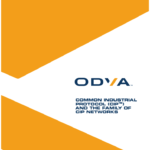ODVA’s networks — including EtherNet/IP™ and DeviceNet® among others — all are linked by one of industrial automation’s most versatile communication protocols: the Common Industrial Protocol, known as CIP™. CIP encompasses a comprehensive suite of messages and services for a broad array of industrial automation applications — including control, safety, energy, synchronization & motion, information and network management. CIP allows users to integrate these applications with enterprise-level Ethernet networks and the Internet. Supported by hundreds of vendors around the world and truly media-independent, CIP provides users with a unified communication architecture throughout the industrial enterprise. CIP allows users to benefit today from the many advantages of open networks and protects their existing automation investments, while providing an extensible and upgradable communication architecture for the future.
CIP is a media independent protocol using a producer-consumer communication model, and is a strictly object oriented protocol at the upper layers. Each CIP object has attributes (data), services (commands), connections, and behaviors (relationship between attribute values and services). CIP includes an extensive object library to support general purpose network communications, network services such as file transfer, and typical automation functions such as analog and digital input/output devices, HMI, motion control and position feedback.
To provide interoperability, the same object (or group of objects) implemented in two or more devices behaves identically from device to device. A grouping of objects used in a device is referred to as that device’s “Object Model.” The Object Model in CIP is based on the producer-consumer communication model, which can provide more efficient use of network resources than a source-destination model by allowing the exchange of application information between a sending device (e.g., the producer) and many receiving devices (e.g., the consumers) without requiring data to be transmitted multiple times by a single source to multiple destinations.
To provide further interoperability within CIP Networks that are made up of devices from multiple vendors, CIP defines a standard grouping of objects known as “Device Profiles.” In addition to the set of objects implemented in the device, Device Profiles specify configuration options and I/O data formats. Devices that implement one of the standard Device Profiles will respond to all the same commands and will have the same network behavior as the other devices that follow that same profile. CIP also can provide simple integration of Modbus, HART, and IO-Link devices through the use of native translation services.
CIP’s common application layer allows complete integration of control with information, multiple CIP Networks and Internet technologies. Built on a single, media-independent platform with a common application layer, CIP provides seamless communication from the plant floor to the enterprise with a scalable and coherent architecture. CIP allows companies to integrate I/O control, device configuration and data collection across multiple networks. This ultimately helps minimize engineering and installation time and costs while maximizing ROI via the following attributes:
- Comprehensive suite of messages and services for industrial automation provides the functionality needed for control, safety, energy, synchronization & motion, information and network management.
- Producer-consumer architecture allows efficient use of network bandwidth with an extensible network footprint.
- Seamless bridging and routing allows flexible topology schemes for network architectures without having to program or configure intermediate devices.
- Device profiles provide a common application interface.

A variety of publications on CIP can be accessed via the Document Library, including The Common Industrial Protocol and the Family of CIP Networks, which can help you understand important terminology and learn the basic architecture of ODVA technologies. Learn more about the distinctive services provided by CIP as well, including CIP Safety™, CIP Security™, CIP Energy™, CIP Sync™, and CIP Motion™.


